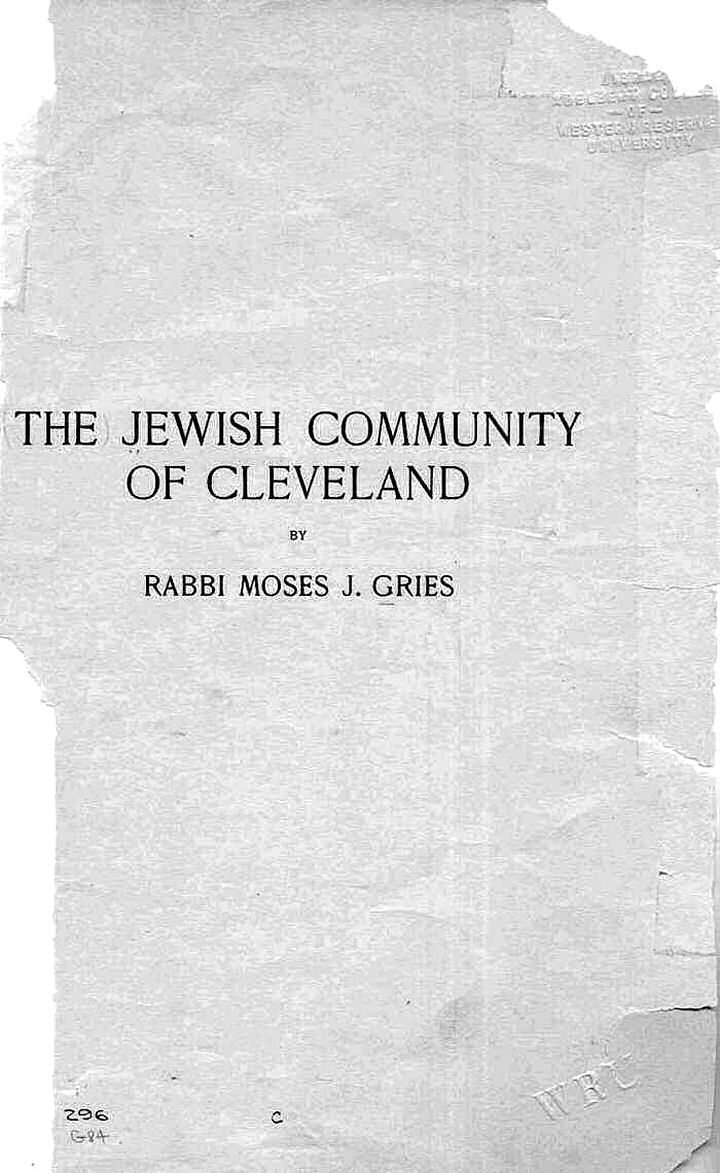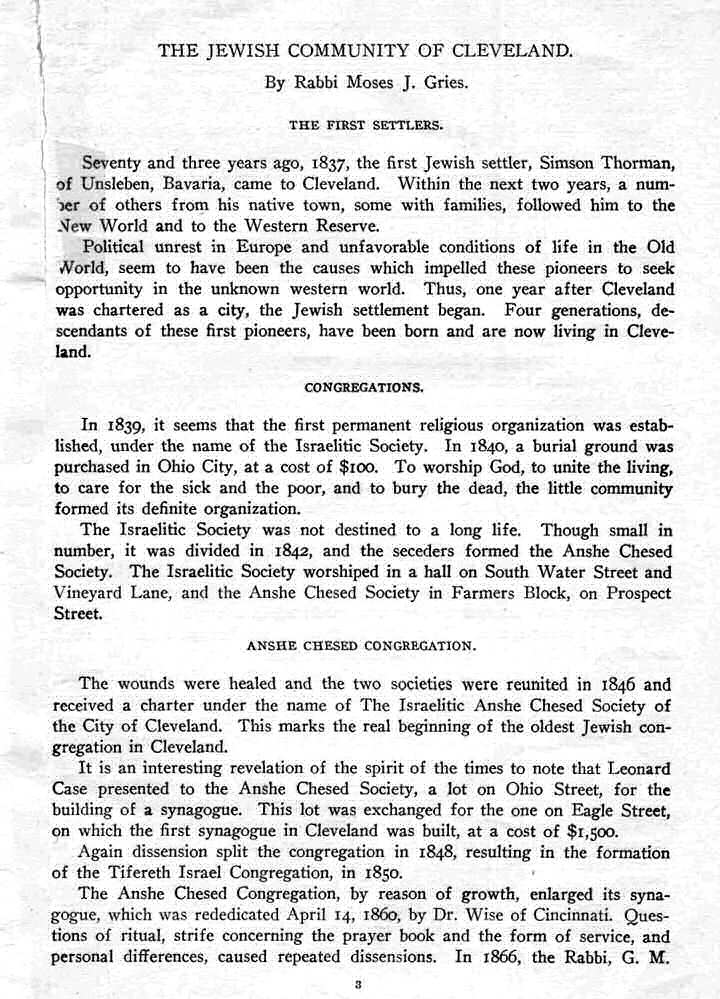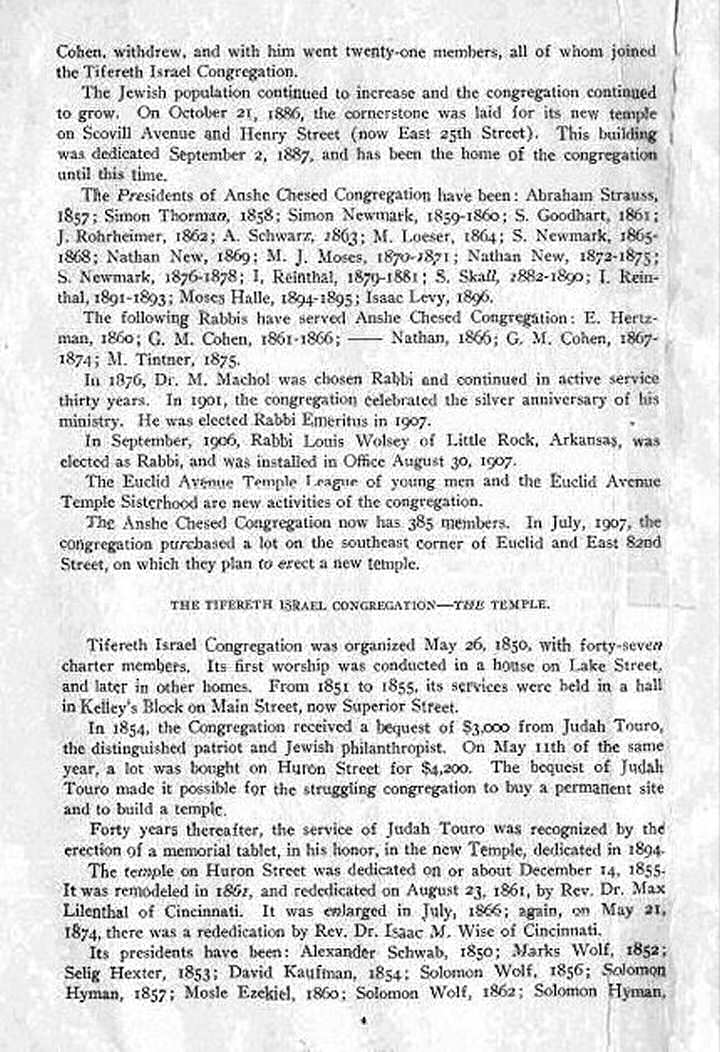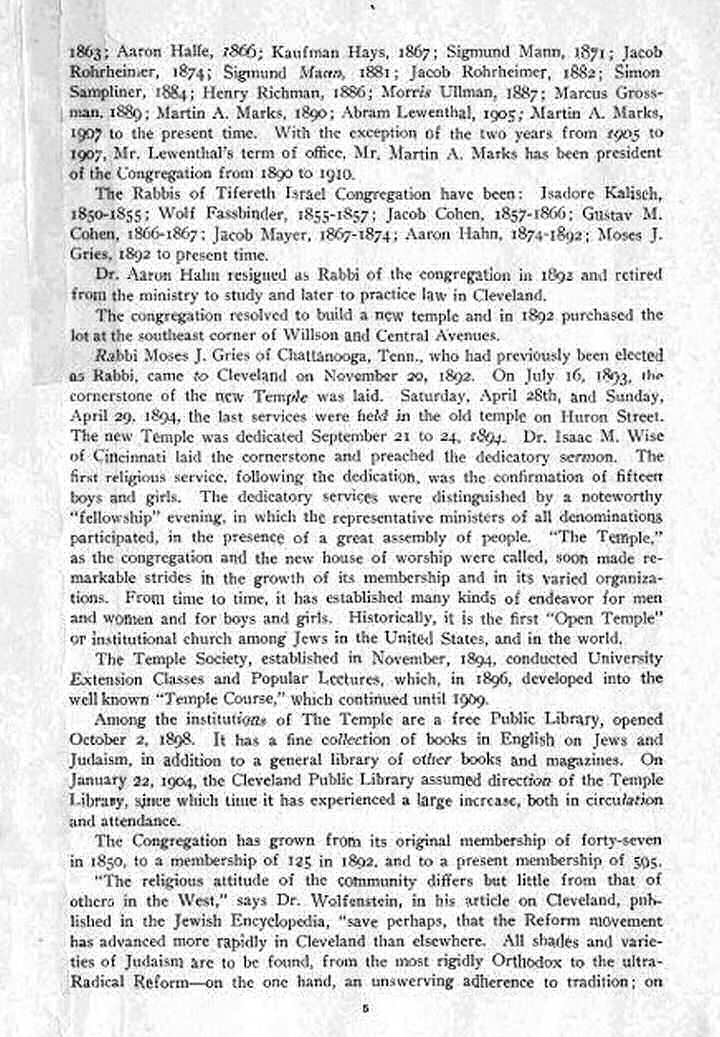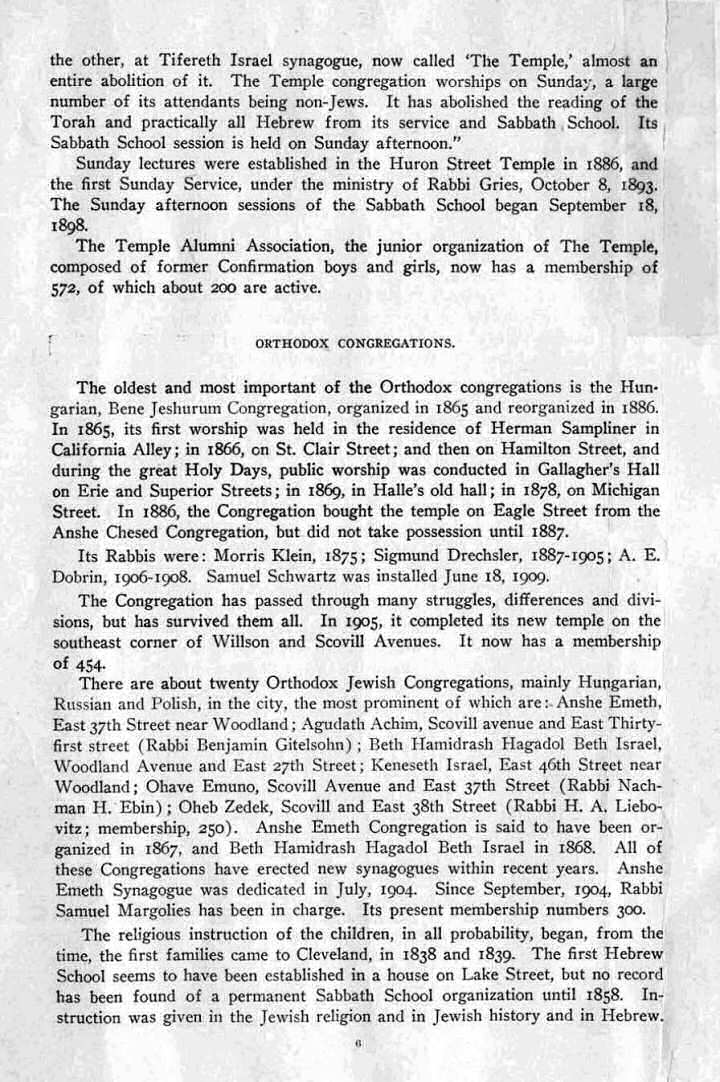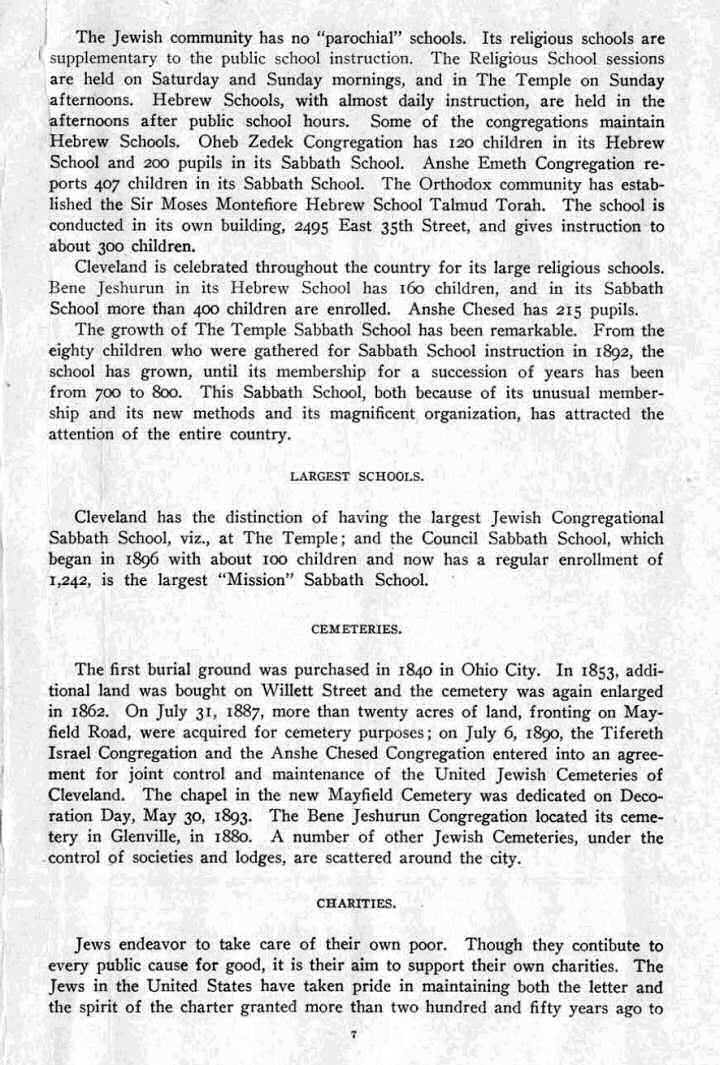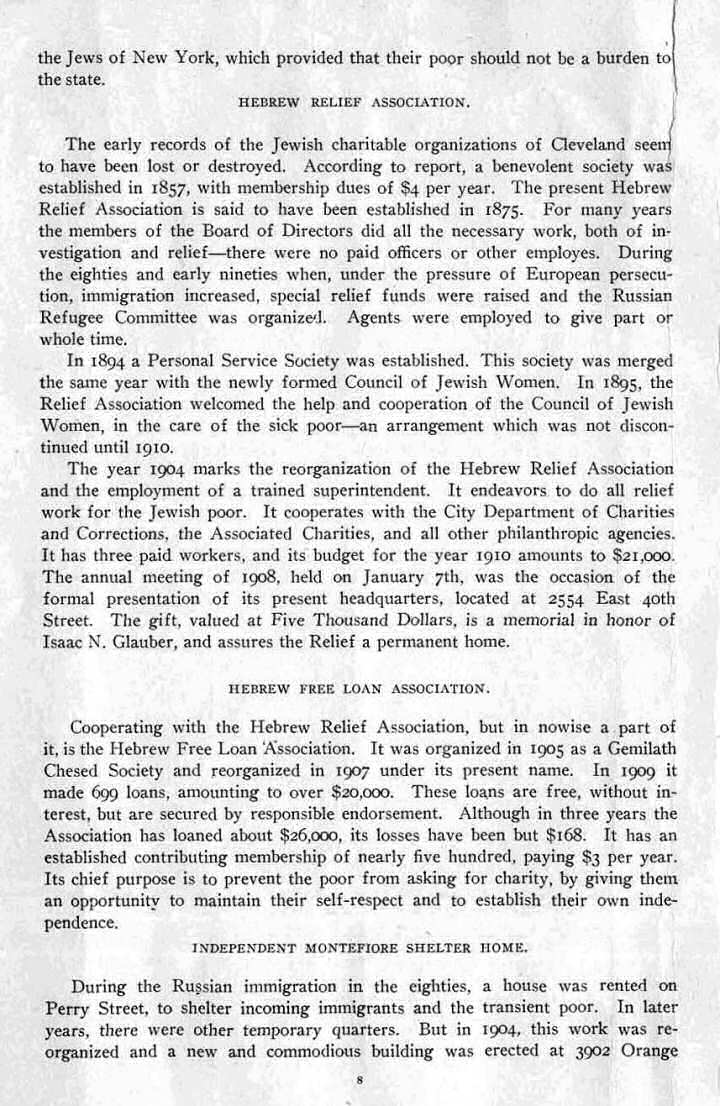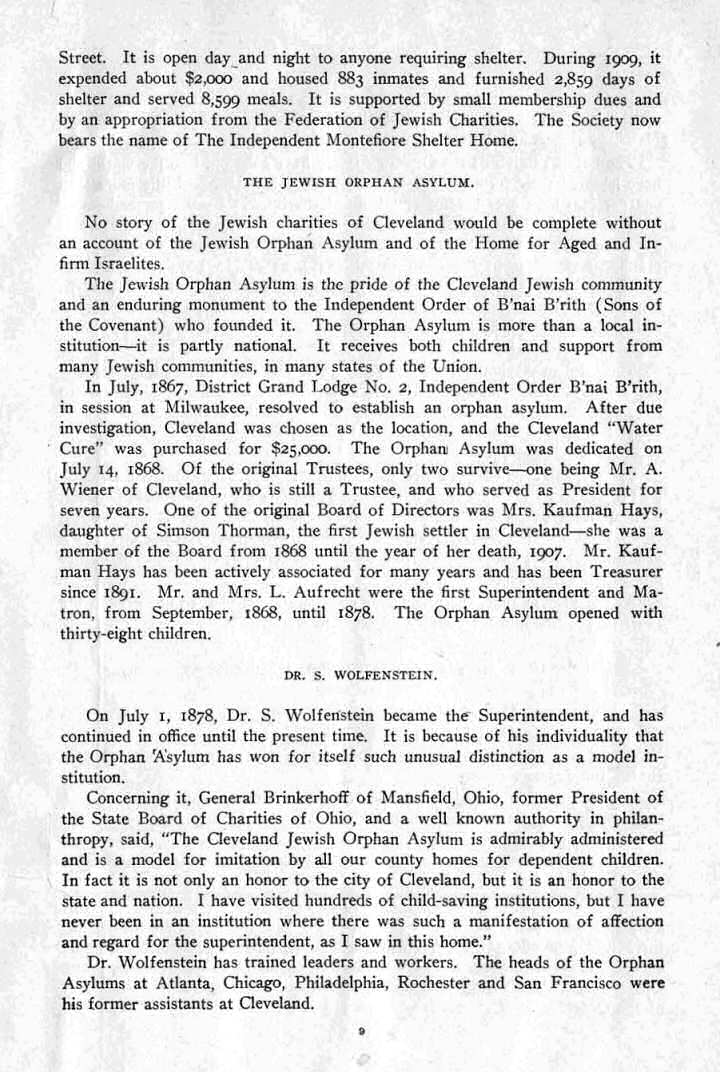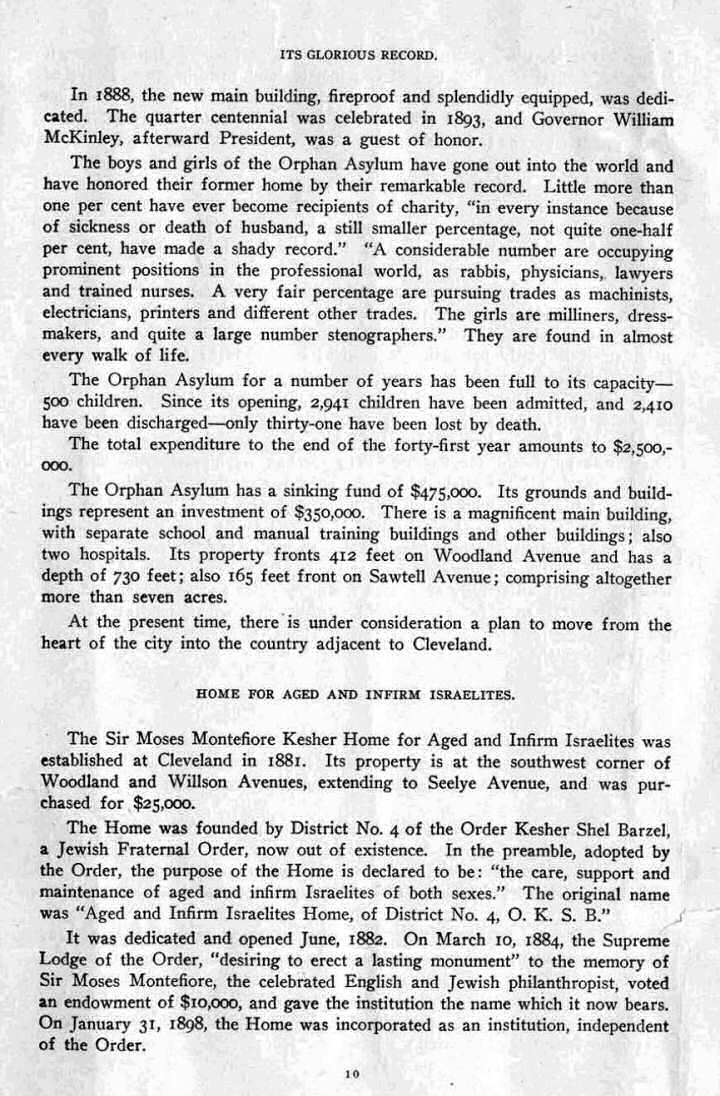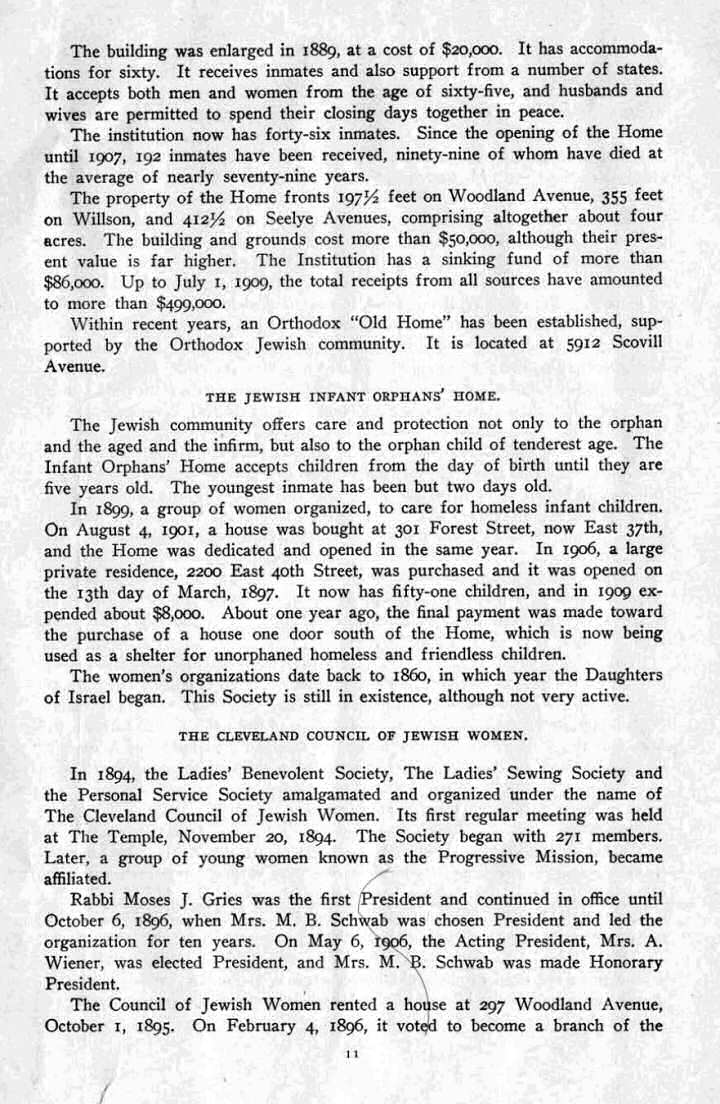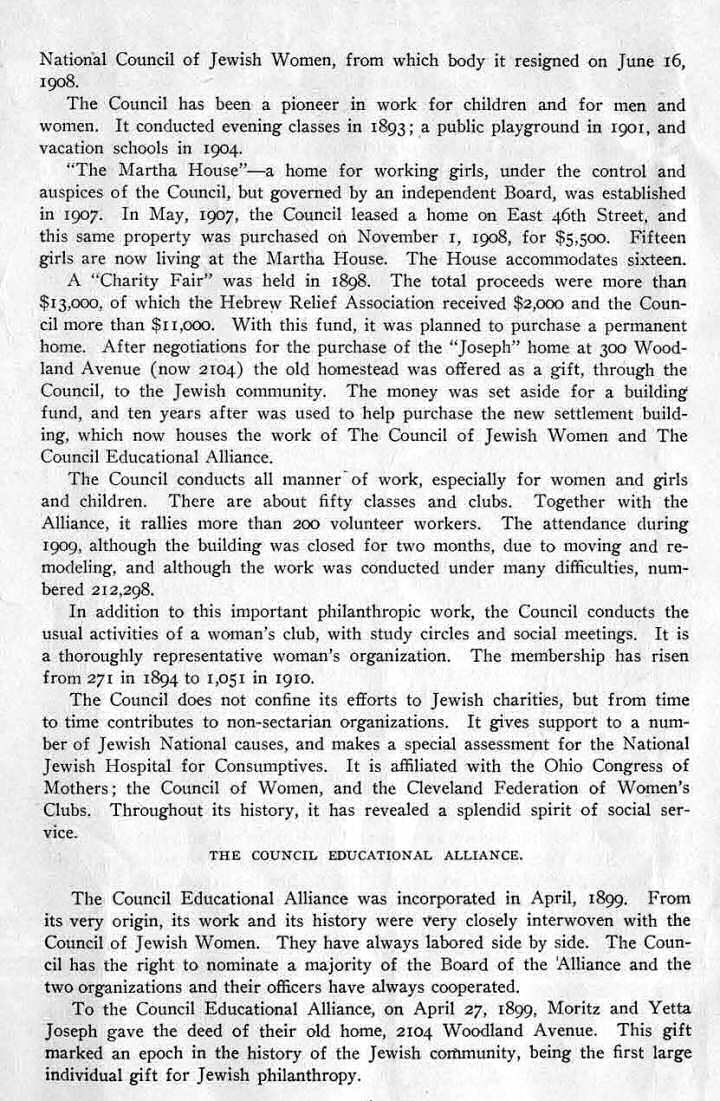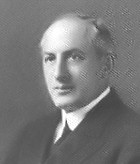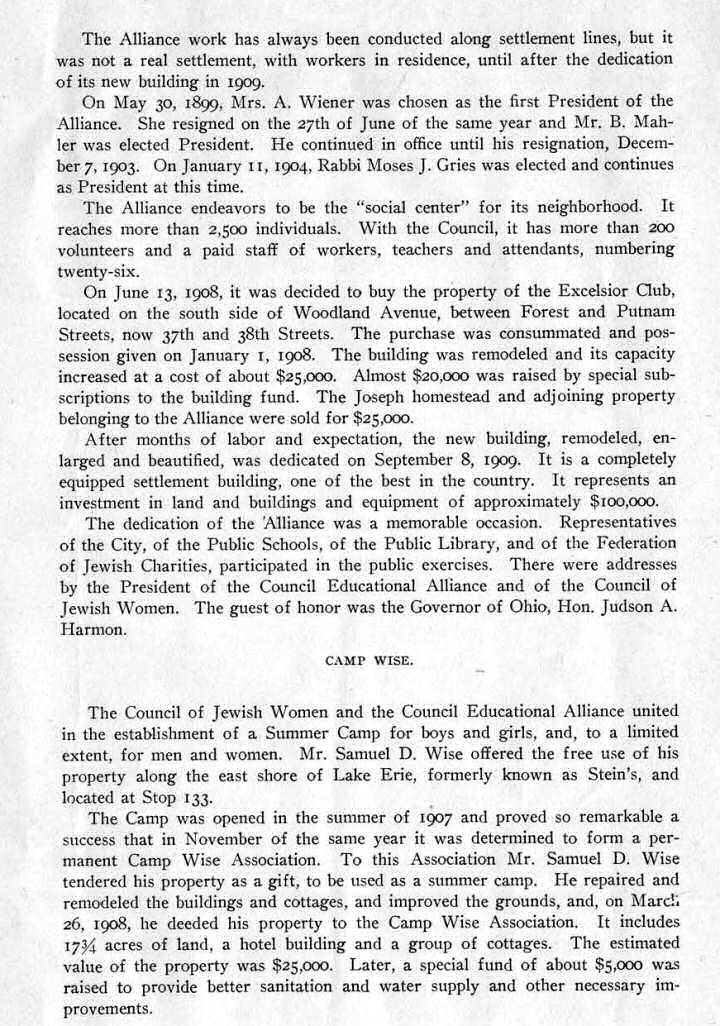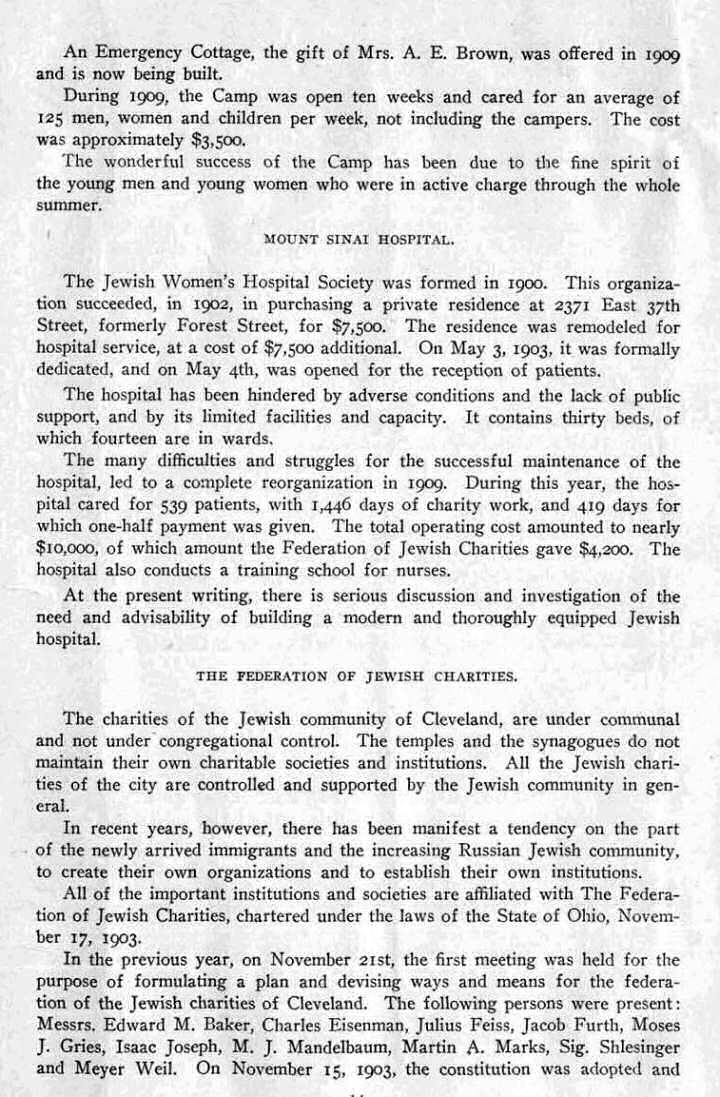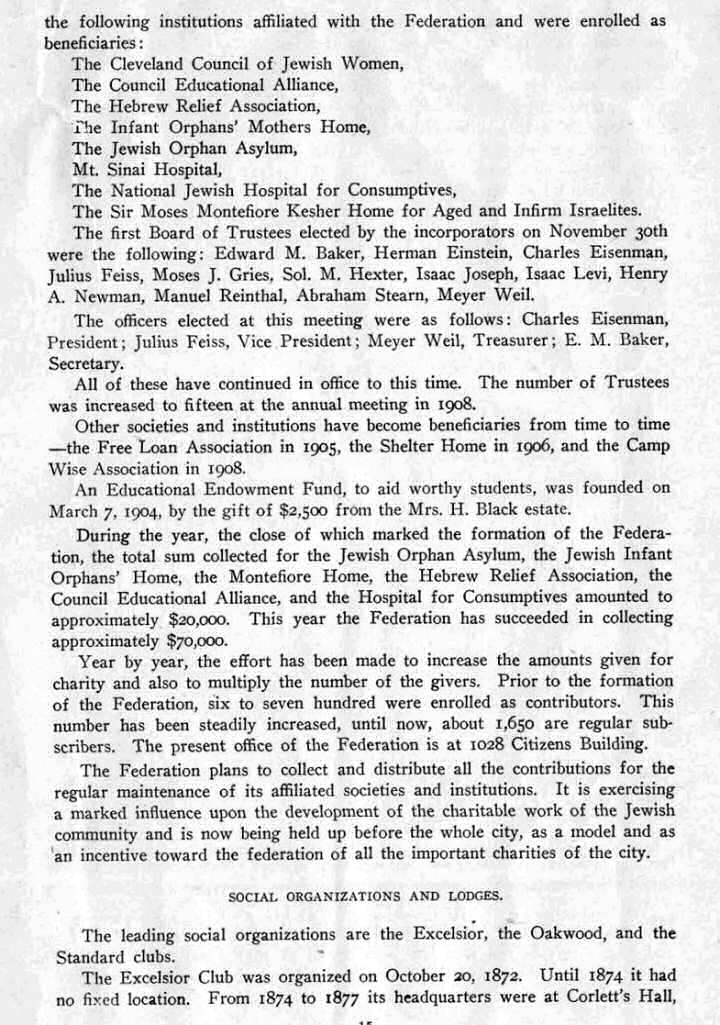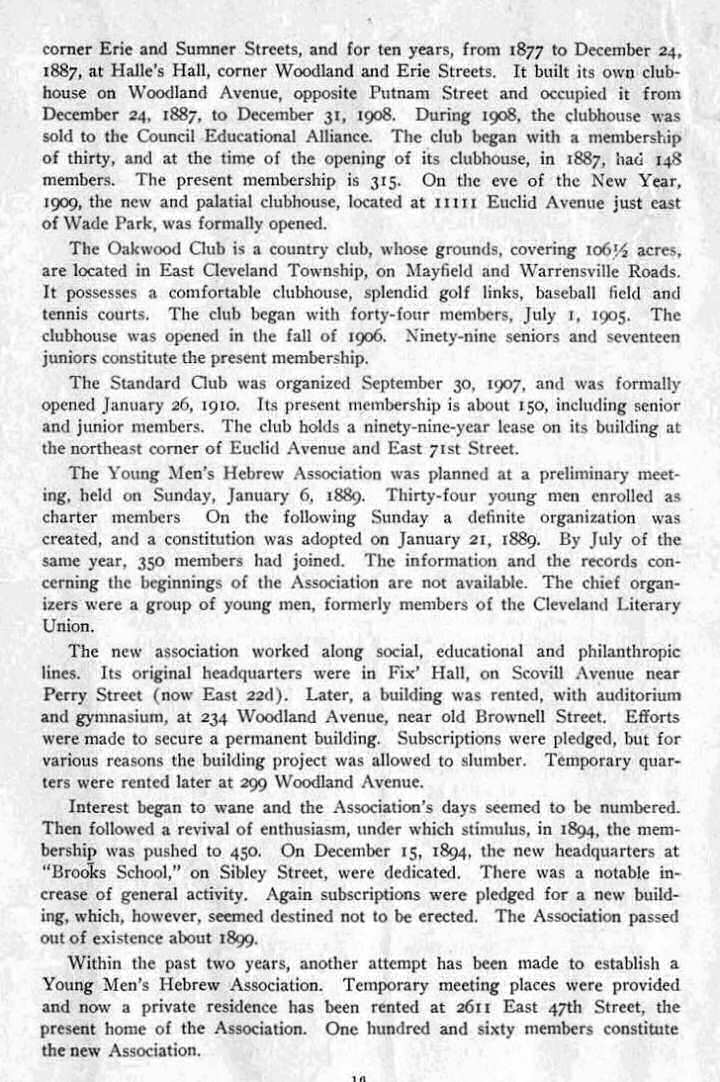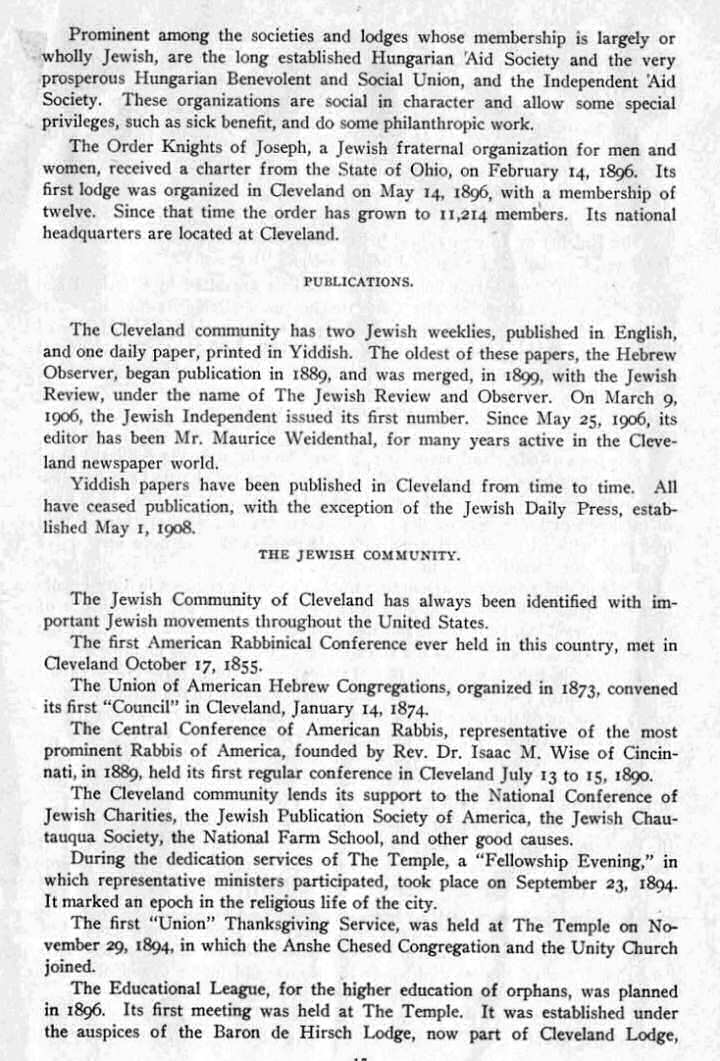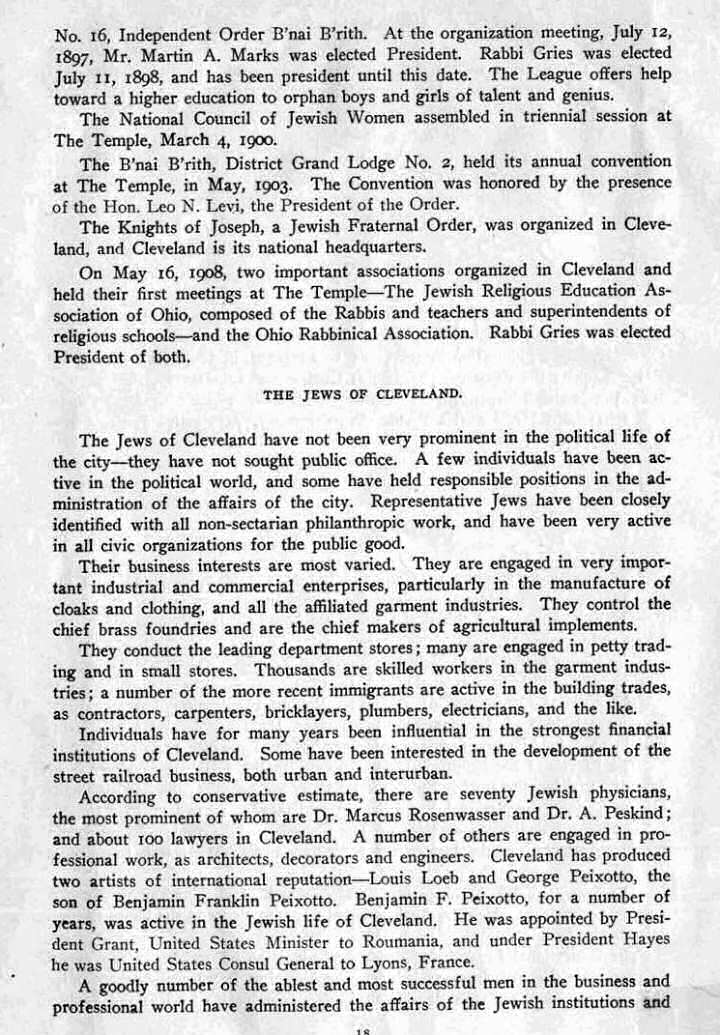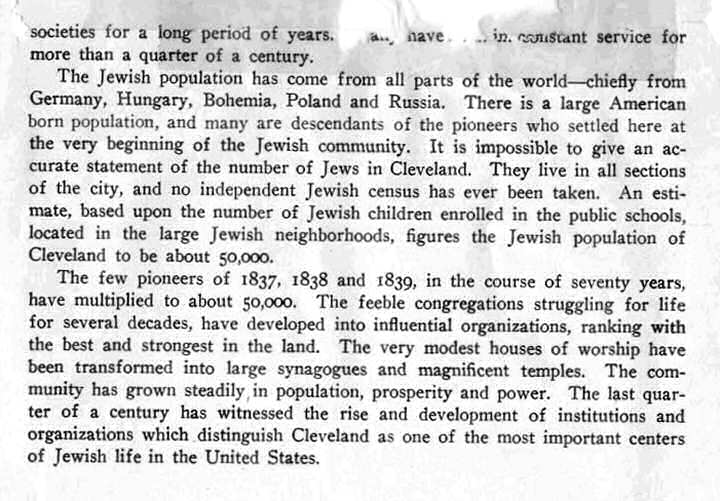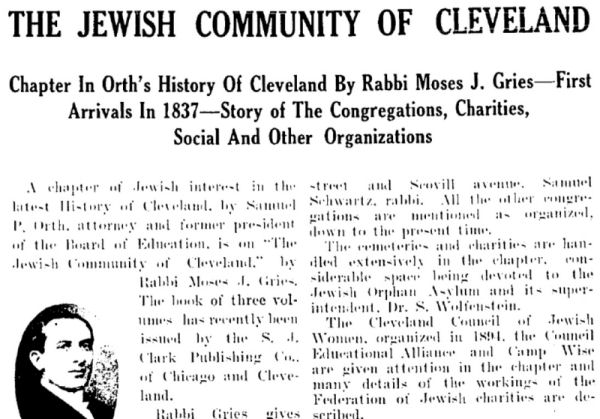|
THE JEWISH COMMUNITY OF
CLEVELAND RABBI MOSES J. GRIES
1910
--------------------------------------------------------------------------------
THE FIRST SETTLERS
Seventy and three years ago, 1837, the first Jewish settler,
Simson Thorman, of Unsleben, Bavaria, came to Cleveland.
Within the next two years, a number of others from his
native town, some with families, followed him to the New
World and to the Western Reserve.
Political unrest in Europe and unfavorable conditions of
life in the Old World, seem to have been the causes which
impelled these pioneers to seek opportunity in the unknown
western world. Thus, one year after Cleveland was chartered
as a city, the Jewish settlement began. Four generations,
descendants of these first pioneers, have been born and are
now living in Cleveland.
CONGREGATIONS.
In 1839, it seems that the first permanent religious
organization was established, under the name of the
Israelitic Society. In 1840, a burial ground was purchased
in Ohio City, at a cost of $100. To worship God, to unite
the living, to care for the sick and the poor, and to bury
the dead, the little community formed its definite
organization.
The Israelitic Society was not destined to a long life.
Though small in number, it was divided in 1842, and the
seceders formed the Anshe Chesed Society. The Israelitic
Society worshiped in a hall on South Water Street and
Vineyard Lane, and the Anshe Chesed Society in Farmers
Block, on Prospect Street.
ANSHE CHESED CONGREGATION.
The wounds were healed and the two societies were reunited
in 1846 and received a charter under the name of The
Israelitic Anshe Chesed Society of the City of Cleveland.
This marks the real beginning of the oldest Jewish
congregation in Cleveland.
It is an interesting revelation of the spirit of the times
to note that Leonard Case presented to the Anshe Chesed
Society, a lot on Ohio Street, for the building of a
synagogue. This lot was exchanged for the one on Eagle
Street, on which the first synagogue in Cleveland was built,
at a cost of $1,500.
Again dissension split the congregation in 1848, resulting
in the formation of the Tifereth Israel Congregation, in
1850.
The Anshe Chesed Congregation, by reason of growth, enlarged
its synagogue, which was rededicated April 14, i860, by Dr.
Wise of Cincinnati. Questions of ritual, strife concerning
the prayer book and the form of service, and personal
differences, caused repeated dissensions. In 1866, the
Rabbi, G. M. Cohen, withdrew, and with him went twenty-one
members, all of whom joined the Tifereth Israel
Congregation.
The Jewish population continued to increase and the
congregation continued to grow. On October 21, 1886, the
cornerstone was laid for its new temple on Scovill Avenue
and Henry Street (now East 25th Street). This building was
dedicated September 2, 1887, and has been the home of the
congregation until this time.
The Presidents of Anshe Chesed Congregation have been:
Abraham Strauss, 1857; Simon Thorman, 1858; Simon Newmark,
1859-1860; S. Goodhart, 1861; J. Rohrheimer, 1862; A.
Schwarz, 1863; M. Loeser, 1864; S. Newmark, 1865-1868;
Nathan New, 1869; M. J. Moses, 1870-1871; Nathan New,
1872-1875; S. Newmark, 1876-1878; I. Reinthal, 1879-1881; S.
Skall, 1882-1890; I. Reinthai, 1891-1893; Moses Halle,
1894-1895; Isaac Levy, 1896.
The following Rabbis have served Anshe Chesed Congregation:
E. Hertzman, i860; G. M. Cohen, 1861-1866; Nathan, 1866; G.
M. Cohen, 1867-1874; M. Tintner, 1875.
In 1876, Dr. M. Machol was chosen Rabbi and continued in
active service thirty years. In 1901, the congregation
celebrated the silver anniversary of his ministry. He was
elected Rabbi Emeritus in 1907.
In September, 1906, Rabbi Louis Wolsey of Little Rock,
Arkansas, was elected as Rabbi, and was installed in Office
August 30, 1907.
The Euclid Avenue Temple League of young men and the Euclid
Avenue Temple Sisterhood are new activities of the
congregation.
The Anshe Chesed Congregation now has 385 members. In July,
1907, the congregation purchased a lot on the southeast
corner of Euclid and East 82nd Street, on which they plan to
erect a new temple.
THE TIFERETH ISRAEL CONGREGATION THE TEMPLE.
Tifereth Israel Congregation was organized May 26, 1850,
with forty-seven charter members. Its first worship was
conducted in a house on Lake Street, and later in other
homes. From 1851 to 1855, its services were held in a hall
in Kelley's Block on Main Street, now Superior Street.
In 1854, the Congregation received a bequest of $3,000 from
Judah Touro, the distinguished patriot and Jewish
philanthropist. On May 11th of the same year, a lot was
bought on Huron Street for $4,200. The bequest of Judah
Touro made it possible for the struggling congregation to
buy a permanent site and to build a temple.
Forty years thereafter, the service of Judah Touro was
recognized by the erection of a memorial tablet, in his
honor, in the new Temple, dedicated in 1894.
The temple on Huron Street was dedicated on or about
December 14, 1855. It was remodeled in 1861, and rededicated
on August 23, 1861, by Rev. Dr. Max Lilenthal of Cincinnati.
It was enlarged in July, 1866; again, on May 21, 1874, there
was a rededication by Rev. Dr. Isaac M. Wise of Cincinnati.
Its presidents have been: Alexander Schwab, 1850; Marks
Wolf, 1852; Selig Hexter, 1853; David Kaufman, 1854; Solomon
Wolf, 1856; Solomon Hyman, 1857; Mosle Ezekiel, 1860;
Solomon Wolf, 1862; Solomon Hyman, 1863; Aaron Halle, 1866;
Kaufman Hays, 1867; Sigmund Mann, 1871; Jacob Rohrheimer,
1874; Sigmund Mann, 1881; Jacob Rohrheimer, 1882; Simon
Sampliner, 1884; Henry Richman, 1886; Morris Ullman, 1887;
Marcus Grossman, 1889; Martin A. Marks, 1890; Abram Lewenthal, 1905; Martin A. Marks, 1907 to the present time.
With the exception of the two years from 1905 to 1907, Mr.
Lewenthal's term of office, Mr. Martin A. Marks has been
president of the Congregation from 1890 to 1910.
The Rabbis of Tifereth Israel Congregation have been:
Isadore Kalisch, 1850-1855; Wolf Fassbinder, 1855-1857;
Jacob Cohen, 1857-1866; Gustav M. Cohen, 1866-1867; Jacob
Mayer, 1867-1874; Aaron Hahn, 1874-1892; Moses J. Gries,
1892 to present time.
Dr. Aaron Hahn resigned as Rabbi of the congregation in 1892
and retired from the ministry to study and later to practice
law in Cleveland.
The congregation resolved to build a new temple and in 1892
purchased the lot at the southeast corner of Willson and
Central Avenues.
Rabbi Moses J. Gries of Chattanooga, Tenn., who had
previously been elected as Rabbi, came to Cleveland on
November 20, 1892. On July 16, 1893, the cornerstone of the
new Temple was laid. Saturday, April 28th, and Sunday, April
29, 1894, the last services were held in the old temple on
Huron Street. The new Temple was dedicated September 21 to
24, 1894. Dr. Isaac M. Wise of Cincinnati laid the
cornerstone and preached the dedicatory sermon. The first
religious service, following the dedication, was the
confirmation of fifteen boys and girls. The dedicatory
services were distinguished by a noteworthy "fellowship"
evening, in which the representative ministers of all
denominations participated, in the presence of a great
assembly of people. "The Temple," as the congregation and
the new house of worship were called, soon made remarkable
strides in the growth of its membership and in its varied
organizations. From time to time, it has established many
kinds of endeavor for men and women and for boys and girls.
Historically, it is the first "Open Temple" or institutional
church among Jews in the United States, and in the world.
The Temple Society, established in November, 1894, conducted
University Extension Classes and Popular Lectures, which, in
1896, developed into the well known "Temple Course," which
continued until 1909.
Among the institutions of The Temple are a free Public
Library, opened October 2, 1898. It has a fine collection of
books in English on Jews and Judaism, in addition to a
general library of other books and magazines. On January 22,
1904, the Cleveland Public Library assumed direction of the
Temple Library, since which time it has experienced a large
increase, both in circulation and attendance.
The Congregation has grown from its original membership of
forty-seven in 1850, to a membership of 125 in 1892, and to
a present membership of 595.
"The religious attitude of the community differs but little
from that of others in the West," says Dr. Wolfenstein, in
his article on Cleveland, published in the Jewish
Encyclopedia, "save perhaps, that the Reform movement has
advanced more rapidly in Cleveland than elsewhere. All
shades and varieties of Judaism are to be found, from the
most rigidly Orthodox to the ultra-Radical Reform — on the one
hand, an unswerving adherence to tradition; on the other, at
Tifereth Israel synagogue, now called 'The Temple,' almost
an entire abolition of it. The Temple congregation worships
on Sunday, a large number of its attendants being non-Jews.
It has abolished the reading of the Torah and practically
all Hebrew from its service and Sabbath School. Its Sabbath
School session is held on Sunday afternoon."
Sunday lectures were established in the Huron Street Temple
in 1886, and the first Sunday Service, under the ministry of
Rabbi Gries, October 8, 1893. The Sunday afternoon sessions
of the Sabbath School began September 18, 1898.
The Temple Alumni Association, the junior organization of
The Temple, composed of former Confirmation boys and girls,
now has a membership of 572, of which about 200 are active.
ORTHODOX CONGREGATIONS.
The oldest and most important of the Orthodox congregations
is the Hungarian, Bene Jeshurum Congregation, organized in
1865 and reorganized in 1886. In 1865, its first worship was
held in the residence of Herman Sampliner in California
Alley; in 1866, on St. Clair Street; and then on Hamilton
Street, and during the great Holy Days, public worship was
conducted in Gallagher's Hall on Erie and Superior Streets;
in 1869, in Halle's old hall; in 1878, on Michigan Street.
In 1886, the Congregation bought the temple on Eagle Street
from the Anshe Chesed Congregation, but did not take
possession until 1887.
Its Rabbis were: Morris Klein, 1875; Sigmund Drechsler,
1887-1905; A. E. Dobrin, 1906-1908. Samuel Schwartz was
installed June 18, 1909.
The Congregation has passed through many struggles,
differences and divisions, but has survived them all. In
1905, it completed its new temple on the southeast corner of
Willson and Scovill Avenues. It now has a membership of 454.
There are about twenty Orthodox Jewish Congregations, mainly
Hungarian, Russian and Polish, in the city, the most
prominent of which are: Anshe Emeth, East 37th Street near
Woodland; Agudath Achim, Scovill avenue and East
Thirty-first street (Rabbi Benjamin Gitelsohn) ; Beth
Hamidrash Hagadol Beth Israel, Woodland Avenue and East 27th
Street; Keneseth Israel, East 46th Street near Woodland;
Ohave Emuno, Scovill Avenue and East 37th Street (Rabbi Nachman
H. Ebin); Oheb Zedek, Scovill and East 38th Street (Rabbi
H. A. Liebovitz; membership, 250). Anshe Emeth Congregation
is said to have been organized in 1867, and Beth Hamidrash
Hagadol Beth Israel in 1868. All of these Congregations have
erected new synagogues within recent years. Anshe Emeth
Synagogue was dedicated in July, 1904. Since September,
1904, Rabbi Samuel Margolies has been in charge. Its present
membership numbers 300.
The religious instruction of the children, in all
probability, began, from the time, the first families came
to Cleveland, in 1838 and 1839. The first Hebrew School
seems to have been established in a house on Lake Street,
but no record has been found of a permanent Sabbath School
organization until 1858. Instruction was given in the Jewish
religion and in Jewish history and in Hebrew.
The Jewish community has no "parochial" schools. Its
religious schools are supplementary to the public school
instruction. The Religious School sessions are held on
Saturday and Sunday mornings, and in The Temple on Sunday
afternoons. Hebrew Schools, with almost daily instruction,
are held in the afternoons after public school hours. Some
of the congregations maintain Hebrew Schools. Oheb Zedek
Congregation has 120 children in its Hebrew School and 200
pupils in its Sabbath School. Anshe Emeth Congregation
reports 407 children in its Sabbath School. The Orthodox
community has established the Sir Moses Montefiore Hebrew
School Talmud Torah. The school is conducted in its own
building, 2495 East 35th Street, and gives instruction to
about 300 children.
Cleveland is celebrated throughout the country for its large
religious schools. Bene Jeshurun in its Hebrew School has
160 children, and in its Sabbath School more than 400
children are enrolled. Anshe Chesed has 215 pupils.
The growth of The Temple Sabbath School has been remarkable.
From the eighty children who were gathered for Sabbath
School instruction in 1892, the school has grown, until its
membership for a succession of years has been from 700 to
800. This Sabbath School, both because of its unusual
membership and its new methods and its magnificent
organization, has attracted the attention of the entire
country.
LARGEST SCHOOLS.
Cleveland has the distinction of having the largest Jewish
Congregational Sabbath School, viz., at The Temple; and the
Council Sabbath School, which began in 1896 with about 100
children and now has a regular enrollment of 1,242, is the
largest "Mission" Sabbath School.
CEMETERIES.
The first burial ground was purchased in 1840 in Ohio City.
In 1853, additional land was bought on Willett Street and
the cemetery was again enlarged in 1862. On July 31, 1887,
more than twenty acres of land, fronting on Mayfield Road,
were acquired for cemetery purposes; on July 6, 1890, the
Tifereth Israel Congregation and the Anshe Chesed
Congregation entered into an agreement for joint control and
maintenance of the United Jewish Cemeteries of Cleveland.
The chapel in the new Mayfield Cemetery was dedicated on
Decoration Day, May 30, 1893. The Bene Jeshurun Congregation
located its cemetery in Glenville, in 1880. A number of
other Jewish Cemeteries, under the control of societies and
lodges, are scattered around the city.
CHARITIES.
Jews endeavor to take care of their own poor. Though they
contribute to every public cause for good, it is their aim
to support their own charities. The Jews in the United
States have taken pride in maintaining both the letter and
the spirit of the charter granted more than two hundred and
fifty years ago to the Jews of New York, which provided that
their poor should not be a burden to the state.
HEBREW RELIEF ASSOCIATION.
The early records of the Jewish charitable organizations of
Cleveland seem to have been lost or destroyed. According to
report, a benevolent society was established in 1857, with
membership dues of $4 per year. The present Hebrew Relief
Association is said to have been established in 1875. For
many years the members of the Board of Directors did all the
necessary work, both of investigation and relief—there were
no paid officers or other employees. During the eighties and
early nineties when, under the pressure of European
persecution, immigration increased, special relief funds
were raised and the Russian Refugee Committee was organized.
Agents were employed to give part or whole time.
In 1894 a Personal Service Society was established. This
society was merged the same year with the newly formed
Council of Jewish Women. In 1895, the Relief Association
welcomed the help and cooperation of the Council of Jewish
Women, in the care of the sick poor—an arrangement which was
not discontinued until 1910.
The year 1904 marks the reorganization of the Hebrew Relief
Association and the employment of a trained superintendent.
It endeavors to do all relief work for the Jewish poor. It
cooperates with the City Department of Charities and
Corrections, the Associated Charities, and all other
philanthropic agencies. It has three paid workers, and its
budget for the year 1910 amounts to $21,000. The annual
meeting of 1908, held on January 7th, was the occasion of
the formal presentation of its present headquarters, located
at 2554 East 40th Street. The gift, valued at Five Thousand
Dollars, is a memorial in honor of Isaac N. Glauber, and
assures the Relief a permanent home.
HEBREW FREE LOAN ASSOCIATION.
Cooperating with the Hebrew Relief Association, but in
nowise a part of it, is the Hebrew Free Loan Association.
It was organized in 1905 as a Gemilatb Chesed Society and
reorganized in 1907 under its present name. In 1909 it made
699 loans, amounting to over $20,000. These loans are free,
without interest, but are secured by responsible
endorsement. Although in three years the Association has
loaned about $26,000, its losses have been but $168. It has
an established contributing membership of nearly five
hundred, paying $3 per year. Its chief purpose is to prevent
the poor from asking for charity, by giving them an
opportunity to maintain their self-respect and to establish
their own independence.
INDEPENDENT MONTEFIORE SHELTER HOME.
During the Russian immigration in the eighties, a house was
rented on Perry Street, to shelter incoming immigrants and
the transient poor. In later years, there were other
temporary quarters. But in 1904, this work was reorganized
and a new and commodious building was erected at 3902 Orange
Street. It is open day and night to anyone requiring
shelter. During 1909, it expended about $2,000 and housed
883 inmates and furnished 2,859 days of shelter and served
8,599 meals. It is supported by small membership dues and by
an appropriation from the Federation of Jewish Charities.
The Society now bears the name of The Independent Montefiore
Shelter Home.
THE JEWISH ORPHAN ASYLUM.
No story of the Jewish charities of Cleveland would be
complete without an account of the Jewish Orphan Asylum and
of the Home for Aged and Infirm Israelites.
The Jewish Orphan Asylum is the pride of the Cleveland
Jewish community and an enduring monument to the Independent
Order of B'nai B'rith (Sons of the Covenant) who founded it.
The Orphan Asylum is more than a local institution—it is
partly national. It receives both children and support from
many Jewish communities, in many states of the Union.
In July, 1867, District Grand Lodge No. 2, Independent Order
B'nai B'rith, in session at Milwaukee, resolved to establish
an orphan asylum. After due investigation, Cleveland was
chosen as the location, and the Cleveland "Water Cure" was
purchased for $25,000. The Orphan Asylum was dedicated on
July 14, 1868. Of the original Trustees, only two
survive—one being Mr. A. Wiener of Cleveland, who is still a
Trustee, and who served as President for seven years. One of
the original Board of Directors was Mrs. Kaufman Hays,
daughter of Simson Thorman, the first Jewish settler in
Cleveland—she was a member of the Board from 1868 until the
year of her death, 1907. Mr. Kaufman Hays has been actively
associated for many years and has been Treasurer since 1891.
Mr. and Mrs. L. Aufrecht were the first Superintendent and
Matron, from September, 1868, until 1878. The Orphan Asylum
opened with thirty-eight children.
DR. S. WOLFENSTEIN.
On July 1, 1878, Dr. S. Wolfenstein became the
Superintendent, and has continued in office until the
present time. It is because of his individuality that the
Orphan 'Asylum has won for itself such unusual distinction
as a model institution.
Concerning it, General Brinkerhoff of Mansfield, Ohio,
former President of the State Board of Charities of Ohio,
and a well known authority in philanthropy, said, "The
Cleveland Jewish Orphan Asylum is admirably administered and
is a model for imitation by all our county homes for
dependent children. In fact it is not only an honor to the
city of Cleveland, but it is an honor to the state and
nation. I have visited hundreds of child-saving
institutions, but I have never been in an institution where
there was such a manifestation of affection and regard for
the superintendent, as I saw in this home."
Dr. Wolfenstein has trained leaders and workers. The heads
of the Orphan Asylums at Atlanta, Chicago, Philadelphia,
Rochester and San Francisco were his former assistants at
Cleveland.
ITS GLORIOUS RECORD.
In 1888, the new main building, fireproof and splendidly
equipped, was dedicated. The quarter centennial was
celebrated in 1893, and Governor William McKinley, afterward
President, was a guest of honor.
The boys and girls of the Orphan Asylum have gone out into
the world and have honored their former home by their
remarkable record. Little more than one per cent have ever
become recipients of charity, "in every instance because of
sickness or death of husband, a still smaller percentage,
not quite one-half per cent, have made a shady record." "A
considerable number are occupying prominent positions in the
professional world, as rabbis, physicians, lawyers and
trained nurses. A very fair percentage are pursuing trades
as machinists, electricians, printers and different other
trades. The girls are milliners, dressmakers, and quite a
large number stenographers." They are found in almost every
walk of life.
The Orphan Asylum for a number of years has been full to its
capacity— 500 children. Since its opening, 2,941 children
have been admitted, and 2,410 have been discharged—only
thirty-one have been lost by death.
The total expenditure to the end of the forty-first year
amounts to $2,500,000.
The Orphan Asylum has a sinking fund of $475,000. Its
grounds and buildings represent an investment of $350,000.
There is a magnificent main building, with separate school
and manual training buildings and other buildings; also two
hospitals. Its property fronts 412 feet on Woodland Avenue
and has a depth of 730 feet; also 165 feet front on Sawtell
Avenue; comprising altogether more than seven acres.
At the present time, there is under consideration a plan to
move from the heart of the city into the country adjacent to
Cleveland.
HOME FOR AGED AND INFIRM ISRAELITES.
The Sir Moses Montefiore Kesher Home for Aged and Infirm
Israelites was established at Cleveland in 1881. Its
property is at the southwest corner of Woodland and Willson
Avenues, extending to Seelye Avenue, and was purchased for
$25,000.
The Home was founded by District No. 4 of the Order Kesher
Shel Barzel, a Jewish Fraternal Order, now out of existence.
In the preamble, adopted by the Order, the purpose of the
Home is declared to be: "the care, support and maintenance
of aged and infirm Israelites of both sexes." The original
name was "Aged and Infirm Israelites Home, of District No.
4, O. K. S. B."
It was dedicated and opened June, 1882. On March 10, 1884,
the Supreme Lodge of the Order, "desiring to erect a lasting
monument" to the memory of Sir Moses Montefiore, the
celebrated English and Jewish philanthropist, voted an
endowment of $10,000, and gave the institution the name
which it now bears. On January 31, 1898, the Home was
incorporated as an institution, independent of the Order.
The building was enlarged in 1889, at a cost of $20,000. It
has accommodations for sixty. It receives inmates and also
support from a number of states. It accepts both men and
women from the age of sixty-five, and husbands and wives are
permitted to spend their closing days together in peace.
The institution now has forty-six inmates. Since the opening
of the Home until 1907, 192 inmates have been received,
ninety-nine of whom have died at the average of nearly
seventy-nine years.
The property of the Home fronts 197 feet on Woodland
Avenue, 355 feet on Willson, and 412 on Seelye Avenues,
comprising altogether about four acres. The building and
grounds cost more than $50,000, although their present value
is far higher. The Institution has a sinking fund of more
than $86,000. Up to July 1, 1909, the total receipts from
all sources have amounted to more than $499,000.
Within recent years, an Orthodox "Old Home" has been
established, supported by the Orthodox Jewish community. It
is located at 5912 Scovill Avenue.
THE JEWISH INFANT ORPHANS' HOME.
The Jewish community offers care and protection not only to
the orphan and the aged and the infirm, but also to the
orphan child of tenderest age. The Infant Orphans' Home
accepts children from the day of birth until they are five
years old. The youngest inmate has been but two days old.
In 1899, a group of women organized, to care for homeless
infant children. On August 4, 1901, a house was bought at
301 Forest Street, now East 37th, and the Home was dedicated
and opened in the same year. In 1906, a large private
residence, 2200 East 40th Street, was purchased and it was
opened on the 13th day of March, 1897. It now has fifty-one
children, and in 1909 expended about $8,000. About one year
ago, the final payment was made toward the purchase of a
house one door south of the Home, which is now being used as
a shelter for unorphaned homeless and friendless children.
The women's organizations date back to 1860, in which year
the Daughters of Israel began. This Society is still in
existence, although not very active.
THE CLEVELAND COUNCIL OF JEWISH WOMEN.
In 1894, the Ladies' Benevolent Society, The Ladies' Sewing
Society and the Personal Service Society amalgamated and
organized under the name of The Cleveland Council of Jewish
Women. Its first regular meeting was held at The Temple,
November 20, 1894. The Society began with 271 members.
Later, a group of young women known as the Progressive
Mission, became affiliated.*
Rabbi Moses J. Gries was the first President and continued
in office until October 6, 1896, when Mrs. M. B. Schwab was
chosen President and led the organization for ten years. On
May 6, 1906, the Acting President, Mrs. A. Wiener, was
elected President, and Mrs. M/*B. Schwab was made Honorary
President.
The Council of Jewish Women rented a house at 297 Woodland
Avenue, October 1, 1895. On February 4, 1896, it voted to
become a branch of the National Council of Jewish Women,
from which body it resigned on June 16, 1908.
The Council has been a pioneer in work for children and for
men and women. It conducted evening classes in 1893; a
public playground in 1901, and vacation schools in 1904.
"The Martha House" — a home for working girls, under the
control and auspices of the Council, but governed by an
independent Board, was established in 1907. In May, 1907,
the Council leased a home on East 46th Street, and this same
property was purchased on November 1, 1908, for $5,500.
Fifteen girls are now living at the Martha House. The House
accommodates sixteen.
A "Charity Fair" was held in 1898. The total proceeds were
more than $13,000, of which the Hebrew Relief Association
received $2,000 and the Council more than $11,000. With this
fund, it was planned to purchase a permanent home. After
negotiations for the purchase of the "Joseph" home at 300
Woodland Avenue (now 2104) the old homestead was offered as
a gift, through the Council, to the Jewish community. The
money was set aside for a building fund, and ten years after
was used to help purchase the new settlement building, which
now houses the work of The Council of Jewish Women and The
Council Educational Alliance.
The Council conducts all manner of work, especially for
women and girls and children. There are about fifty classes
and clubs. Together with the Alliance, it rallies more than
200 volunteer workers. The attendance during 1909, although
the building was closed for two months, due to moving and
remodeling, and although the work was conducted under many
difficulties, numbered 212,298.
In addition to this important philanthropic work, the
Council conducts the usual activities of a woman's club,
with study circles and social meetings. It is a thoroughly
representative woman's organization. The membership has
risen from 271 in 1894 to 1,051 in 1910.
The Council does not confine its efforts to Jewish
charities, but from time to time contributes to
non-sectarian organizations. It gives support to a number of
Jewish National causes, and makes a special assessment for
the National Jewish Hospital for Consumptives. It is
affiliated with the Ohio Congress of Mothers; the Council of
Women, and the Cleveland Federation of Women's Clubs.
Throughout its history, it has revealed a splendid spirit of
social service.
THE COUNCIL EDUCATIONAL ALLIANCE.
The Council Educational Alliance was incorporated in April,
1899. From its very origin, its work and its history were
very closely interwoven with the Council of Jewish Women.
They have always labored side by side. The Council has the
right to nominate a majority of the Board of the Alliance
and the two organizations and their officers have always
cooperated.
To the Council Educational Alliance, on April 27, 1899,
Moritz and Yetta Joseph gave the deed of their old home,
2104 Woodland Avenue. This gift marked an epoch in the
history of the Jewish community, being the first large
individual gift for Jewish philanthropy.
The Alliance work has always been conducted along settlement
lines, but it was not a real settlement, with workers in
residence, until after the dedication of its new building in
1909.
On May 30, 1899, Mrs. A. Wiener was chosen as the first
President of the Alliance. She resigned on the 27th of June
of the same year and Mr. B. Mahler was elected President. He
continued in office until his resignation, December 7,1903.
On January 11, 1904, Rabbi Moses J. Gries was elected and
continues as President at this time.
The Alliance endeavors to be the "social center" for its
neighborhood. It reaches more than 2,500 individuals. With
the Council, it has more than 200 volunteers and a paid
staff of workers, teachers and attendants, numbering
twenty-six.
On June 13, 1908, it was decided to buy the property of the
Excelsior Club, located on the south side of Woodland
Avenue, between Forest and Putnam Streets, now 37th and 38th
Streets. The purchase was consummated and possession given
on January 1, 1908. The building was remodeled and its
capacity increased at a cost of about $25,000. Almost
$20,000 was raised by special subscriptions to the building
fund. The Joseph homestead and adjoining property belonging
to the Alliance were sold for $25,000.
After months of labor and expectation, the new building,
remodeled, enlarged and beautified, was dedicated on
September 8, 1909. It is a completely equipped settlement
building, one of the best in the country. It represents an
investment in land and buildings and equipment of
approximately $100,000.
The dedication of the Alliance was a memorable occasion.
Representatives of the City, of the Public Schools, of the
Public Library, and of the Federation of Jewish Charities,
participated in the public exercises. There were addresses
by the President of the Council Educational Alliance and of
the Council of Jewish Women. The guest of honor was the
Governor of Ohio, Hon. Judson A. Harmon.
CAMP WISE
The Council of Jewish Women and the Council Educational
Alliance united in the establishment of a Summer Camp for
boys and girls, and, to a limited extent, for men and women.
Mr. Samuel D. Wise offered the free use of his property
along the east shore of Lake Erie, formerly known as
Stein's, and located at Stop 133.
The Camp was opened in the summer of 1907 and proved so
remarkable a success that in November of the same year it
was determined to form a permanent Camp Wise Association. To
this Association Mr. Samuel D. Wise tendered his property as
a gift, to be used as a summer camp. He repaired and
remodeled the buildings and cottages, and improved the
grounds, and, on March 26, 1908, he deeded his property to
the Camp Wise Association. It includes 17 acres of land, a
hotel building and a group of cottages. The estimated value
of the property was $25,000. Later, a special fund of about
$5,000 was raised to provide better sanitation and water
supply and other necessary improvements.
An Emergency Cottage, the gift of Mrs. A. E. Brown, was
offered in 1909 and is now being built.
During 1909, the Camp was open ten weeks and cared for an
average of 125 men, women and children per week, not
including the campers. The cost was approximately $3,500.
The wonderful success of the Camp has been due to the fine
spirit of the young men and young women who were in active
charge through the whole summer.
MOUNT SINAI HOSPITAL
The Jewish Women's Hospital Society was formed in 1900. This
organization succeeded, in 1902, in purchasing a private
residence at 2371 East 37th Street, formerly Forest Street,
for $7,500. The residence was remodeled for hospital
service, at a cost of $7,500 additional. On May 3, 1903, it
was formally dedicated, and on May 4th, was opened for the
reception of patients.
The hospital has been hindered by adverse conditions and the
lack of public support, and by its limited facilities and
capacity. It contains thirty beds, of which fourteen are in
wards.
The many difficulties and struggles for the successful
maintenance of the hospital, led to a complete
reorganization in 1909. During this year, the hospital cared
for 539 patients, with 1,446 days of charity work, and 419
days for which one-half payment was given. The total
operating cost amounted to nearly $10,000, of which amount
the Federation of Jewish Charities gave $4,200. The hospital
also conducts a training school for nurses.
At the present writing, there is serious discussion and
investigation of the need and advisability of building a
modern and thoroughly equipped Jewish hospital.
THE FEDERATION OF JEWISH CHARITIES.
The charities of the Jewish community of Cleveland, are
under communal and not under congregational control. The
temples and the synagogues do not maintain their own
charitable societies and institutions. All the Jewish
charities of the city are controlled and supported by the
Jewish community in general.
In recent years, however, there has been manifest a tendency
on the part of the newly arrived immigrants and the
increasing Russian Jewish community, to create their own
organizations and to establish their own institutions.
All of the important institutions and societies are
affiliated with The Federation of Jewish Charities,
chartered under the laws of the State of Ohio, November 17,
1903.
In the previous year, on November 21st, the first meeting
was held for the purpose of formulating a plan and devising
ways and means for the federation of the Jewish charities of
Cleveland. The following persons were present: Messrs.
Edward M. Baker, Charles Eisenman, Julius Feiss, Jacob
Furth, Moses J. Gries, Isaac Joseph, M. J. Mandelbaum,
Martin A- Marks, Sig. Shlesinger and Meyer Weil. On November
15, 1903, the constitution was adopted and he following
institutions affiliated with the Federation and were
enrolled as beneficiaries:
The Cleveland Council of Jewish Women, The Council
Educational Alliance The Hebrew Relief Association, The
Infant Orphans' Mothers Home, The Jewish Orphan Asylum, Mt.
Sinai Hospital, The National Jewish Hospital for
Consumptives, The Sir Moses Montefiore Kesher Home for Aged
and Infirm Israelites.
The first Board of Trustees elected by the incorporators on
November 30th were the following: Edward M. Baker, Herman
Einstein, Charles Eisenman, Julius Feiss, Moses J. Gries,
Sol. M. Hexter, Isaac Joseph, Isaac Levi, Henry A. Newman,
Manuel Reinthal, Abraham Stearn, Meyer Weil.
The officers elected at this meeting were as follows:
Charles Eisenman, President; Julius Feiss, Vice President;
Meyer Weil, Treasurer; E. M. Baker, Secretary.
All of these have continued in office to this time. The
number of Trustees was increased to fifteen at the annual
meeting in 1908.
Other societies and institutions have become beneficiaries
from time to time —the Free Loan Association in 1905, the
Shelter Home in 1906, and the Camp Wise Association in 1908.
An Educational Endowment Fund, to aid worthy students, was
founded on March 7, 1904, by the gift of $2,500 from the
Mrs. H. Black estate.
During the year, the close of which marked the formation of
the Federation, the total sum collected for the Jewish
Orphan Asylum, the Jewish Infant Orphans' Home, the
Montefiore Home, the Hebrew Relief Association, the Council
Educational Alliance, and the Hospital for Consumptives
amounted to approximately $20,000. This year the Federation
has succeeded in collecting approximately $70,000.
Year by year, the effort has been made to increase the
amounts given for charity and also to multiply the number of
the givers. Prior to the formation of the Federation, six to
seven hundred were enrolled as contributors. This number has
been steadily increased, until now, about 1,650 are regular
subscribers. The present office of the Federation is at 1028
Citizens Building.
The Federation plans to collect and distribute all the
contributions for the regular maintenance of its affiliated
societies and institutions. It is exercising a marked
influence upon the development of the charitable work of the
Jewish community and is now being held up before the whole
city, as a model and as an incentive toward the federation
of all the important charities of the city.
SOCIAL ORGANIZATIONS AND LODGES.
The leading social organizations are the Excelsior, the
Oakwood, and the Standard clubs.
The Excelsior Club was organized on October 20, 1872. Until
1874 it had no fixed location. From 1874 to 1877 its
headquarters were at Corlett's Hall, corner Erie and Sumner
Streets, and for ten years, from 1877 to December 24, 1887,
at Halle's Hall, corner Woodland and Erie Streets. It built
its own clubhouse on Woodland Avenue, opposite Putnam Street
and occupied it from December 24, 1887, to December 31,
1908. During 1908, the clubhouse was sold to the Council
Educational Alliance. The club began with a membership of
thirty, and at the time of the opening of its clubhouse, in
1887, had 148 members. The present membership is 315. On the
eve of the New Year, 1909, the new and palatial clubhouse,
located at 11111 Euclid Avenue just east of Wade Park, was
formally opened.
The Oakwood Club is a country club, whose grounds, covering
106 1/2 acres, are located in East Cleveland Township, on
Mayfield and Warrensville Roads. It possesses a comfortable
clubhouse, splendid golf links, baseball field and tennis
courts. The club began with forty-four members, July 1,
1905. The clubhouse was opened in the fall of 1906.
Ninety-nine seniors and seventeen juniors constitute the
present membership.
The Standard Club was organized September 30, 1907, and was
formally opened January 26, 1910. Its present membership is
about 150, including senior and junior members. The club
holds a ninety-nine-year lease on its building at the
northeast corner of Euclid Avenue and East 71st Street.
The Young Men's Hebrew Association was planned at a
preliminary meeting, held on Sunday, January 6, 1889.
Thirty-four young men enrolled as charter members On the
following Sunday a definite organization was created, and a
constitution was adopted on January 21, 1889. By July of the
same year, 350 members had joined. The information and the
records concerning the beginnings of the Association are not
available. The chief organizers were a group of young men,
formerly members of the Cleveland Literary Union.
The new association worked along social, educational and
philanthropic lines. Its original headquarters were in Fix'
Hall, on Scovill Avenue near Perry Street (now East 22d).
Later, a building was rented, with auditorium and gymnasium,
at 234 Woodland Avenue, near old Brownell Street. Efforts
were made to secure a permanent building. Subscriptions were
pledged, but for various reasons the building project was
allowed to slumber. Temporary quarters were rented later at
299 Woodland Avenue.
Interest began to wane and the Association's days seemed to
be numbered. Then followed a revival of enthusiasm, under
which stimulus, in 1894, the membership was pushed to 450.
On December 15, 1894, the new headquarters at "Brooks
School," on Sibley Street, were dedicated. There was a
notable increase of general activity. Again subscriptions
were pledged for a new building, which, however, seemed
destined not to be erected. The Association passed out of
existence about 1899.
Within the past two years, another attempt has been made to
establish a Young Men's Hebrew Association. Temporary
meeting places were provided and now a private residence has
been rented at 2611 East 47th Street, the present home of
the Association. One hundred and sixty members constitute
the new Association.
Prominent among the societies and lodges whose membership is
largely or wholly Jewish, are the long established Hungarian
Aid Society and the very prosperous Hungarian Benevolent and
Social Union, and the Independent Aid Society. These
organizations are social in character and allow some special
privileges, such as sick benefit, and do some philanthropic
work.
The Order Knights of Joseph, a Jewish fraternal organization
for men and women, received a charter from the State of
Ohio, on February 14, 1896. Its first lodge was organized in
Cleveland on May 14, 1896, with a membership of twelve.
Since that time the order has grown to 11,214 members. Its
national headquarters are located at Cleveland.
PUBLICATIONS.
The Cleveland community has two Jewish weeklies, published
in English, and one daily paper, printed in Yiddish. The
oldest of these papers, the Hebrew Observer, began
publication in 1889, and was merged, in 1899, with the
Jewish Review, under the name of The Jewish Review and
Observer. On March 9, 1906, the Jewish Independent issued
its first number. Since May 25, 1906, its editor has been
Mr. Maurice Weidenthal, for many years active in the
Cleveland newspaper world.
Yiddish papers have been published in Cleveland from time to
time. All have ceased publication, with the exception of the
Jewish Daily Press, established May 1, 1908.
THE JEWISH COMMUNITY.
The Jewish Community of Cleveland has always been identified
with important Jewish movements throughout the United
States.
The first American Rabbinical Conference ever held in this
country, met in Cleveland October 17, 1855.
The Union of American Hebrew Congregations, organized in
1873, convened its first "Council" in Cleveland, January 14,
1874.
The Central Conference of American Rabbis, representative of
the most prominent Rabbis of America, founded by Rev. Dr.
Isaac M. Wise of Cincinnati, in 1889, held its first regular
conference in Cleveland July 13 to 15, 1890.
The Cleveland community lends its support to the National
Conference of Jewish Charities, the Jewish Publication
Society of America, the Jewish Chautauqua Society, the
National Farm School, and other good causes.
During the dedication services of The Temple, a "Fellowship
Evening," in which representative ministers participated,
took place on September 23, 1894. It marked an epoch in the
religious life of the city.
The first "Union" Thanksgiving Service, was held at The
Temple on November 29, 1894, in which the Anshe Chesed
Congregation and the Unity Church joined.
The Educational League, for the higher education of orphans,
was planned in 1896. Its first meeting was held at The
Temple. It was established under the auspices of the Baron
de Hirsch Lodge, now part of Cleveland Lodge, No. 16,
Independent Order B'nai B'rith. At the organization meeting,
July 12, 1897, Mr. Martin A. Marks was elected President.
Rabbi Gries was elected July 11, 1898, and has been
president until this date. The League offers help toward a
higher education to orphan boys and girls of talent and
genius.
The National Council of Jewish Women assembled in triennial
session at The Temple, March 4, 1900.
The B'nai B'rith, District Grand Lodge No. 2, held its
annual convention at The Temple, in May, 1903. The
Convention was honored by the presence of the Hon. Leo N.
Levi, the President of the Order.
The Knights of Joseph, a Jewish Fraternal Order, was
organized in Cleveland, and Cleveland is its national
headquarters.
On May 16, 1908, two important associations organized in
Cleveland and held their first meetings at The Temple—The
Jewish Religious Education Association of Ohio, composed of
the Rabbis and teachers and superintendents of religious
schools—and the Ohio Rabbinical Association. Rabbi Gries was
elected President of both.
THE JEWS OF CLEVELAND.
The Jews of Cleveland have not been very prominent in the
political life of the city—they have not sought public
office. A few individuals have been active in the political
world, and some have held responsible positions in the
administration of the affairs of the city. Representative
Jews have been closely identified with all non-sectarian
philanthropic work, and have been very active in all civic
organizations for the public good.
Their business interests are most varied. They are engaged
in very important industrial and commercial enterprises,
particularly in the manufacture of cloaks and clothing, and
all the affiliated garment industries. They control the
chief brass foundries and are the chief makers of
agricultural implements.
They conduct the leading department stores; many are engaged
in petty trading and in small stores. Thousands are skilled
workers in the garment industries; a number of the more
recent immigrants are active in the building trades, as
contractors, carpenters, bricklayers, plumbers,
electricians, and the like.
Individuals have for many years been influential in the
strongest financial institutions of Cleveland. Some have
been interested in the development of the street railroad
business, both urban and interurban.
According to conservative estimate, there are seventy Jewish
physicians, the most prominent of whom are Dr. Marcus
Rosenwasser and Dr. A. Peskind; and about 100 lawyers in
Cleveland. A number of others are engaged in professional
work, as architects, decorators and engineers. Cleveland has
produced two artists of international reputation—Louis Loeb
and George Peixotto, the son of Benjamin Franklin Peixotto.
Benjamin F. Peixotto, for a number of years, was active in
the Jewish life of Cleveland. He was appointed by President
Grant, United States Minister to Roumania, and under
President Hayes he was United States Consul General to
Lyons, France.
A goodly number of the ablest and most successful men in the
business and professional world have administered the
affairs of the Jewish institutions and societies for a long
period of years. [words missing] have [words missing]
constant service for more than a quarter of a century.
The Jewish population has come from all parts of the world —
chiefly from Germany, Hungary, Bohemia, Poland and Russia.
There is a large American born population, and many are
descendants of the pioneers who settled here at the very
beginning of the Jewish community. It is impossible to give
an accurate statement of the number of Jews in Cleveland.
They live in all sections of the city, and no independent
Jewish census has ever been taken. An estimate, based upon
the number of Jewish children enrolled in the public
schools, located in the large Jewish neighborhoods, figures
the Jewish population of Cleveland to be about 50,000.
The few pioneers of 1837, 1838 and 1839, m the course of
seventy years, have multiplied to about 50,000. The feeble
congregations struggling for life for several decades, have
developed into influential organizations, ranking with the
best and strongest in the land. The very modest houses of
worship have been transformed into large synagogues and
magnificent temples. The community has grown steadily, in
population, prosperity and power. The last quarter of a
century has witnessed the rise and development of
institutions and organizations which distinguish Cleveland
as one of the most important centers of Jewish life in the
United States. ● |
